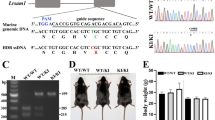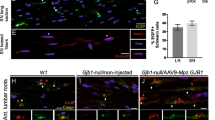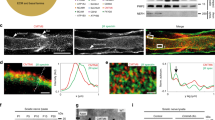Abstract
The hereditary motor and sensory neuropathies (also known as Charcot–Marie–Tooth disease or CMT) are characterized by a length-dependent loss of axonal integrity in the PNS, which leads to progressive muscle weakness and sensory deficits. The 'demyelinating' neuropathies (CMT disease types 1 and 4) are genetically heterogeneous, but their common feature is that the primary defect perturbs myelination. As we discuss in this Review, several new genes associated with CMT1 and CMT4 have recently been identified. The emerging view is that a range of different subcellular defects in Schwann cells can cause axonal loss, which represents the final common pathway of all CMT disease and is independent of demyelination. We propose that Schwann cells provide a first line of axonal neuroprotection. A better understanding of axon–glia interactions should open the way to therapeutic interventions for demyelinating neuropathies. Transgenic animal models have become essential for dissecting CMT disease mechanisms and exploring novel therapies.
Key Points
-
The inherited demyelinating neuropathies Charcot–Marie–Tooth (CMT) disease types 1 and 4 are genetically heterogeneous, but their common feature is that the primary defect perturbs myelination
-
All mutations that cause CMT1 have almost complete penetrance, and the mutated genes are expressed in myelinating Schwann cells
-
The products of CMT-associated genes include not only structural components of myelin, but also proteins that have signalling and regulatory functions in Schwann cells
-
Axonal loss seems to be the final common pathway of all CMT disease
-
Knowing the primary causes of demyelination and obtaining insights into the downstream mechanisms of neuropathies are the first steps towards developing rational treatment strategies for CMT disease
This is a preview of subscription content, access via your institution
Access options
Subscribe to this journal
Receive 12 print issues and online access
$209.00 per year
only $17.42 per issue
Buy this article
- Purchase on Springer Link
- Instant access to full article PDF
Prices may be subject to local taxes which are calculated during checkout

Similar content being viewed by others
References
Shy ME et al. (2005) Principles of classifications, clinical syndromes. In Peripheral Neuropathy, edn 4 (2 vols) 1623–1658 (Eds Dyck PJ and Thomas PK) Philadelphia: Elsevier Saunders
Züchner S and Vance JM (2006) Mechanisms of disease: a molecular genetic update on hereditary axonal neuropathies. Nat Clin Pract Neurol 2: 45–53
Killian JM et al. (1996) Longitudinal studies of the duplication form of Charcot–Marie–Tooth polyneuropathy. Muscle Nerve 19: 74–78
Birouk N et al. (1997) Charcot–Marie–Tooth disease type 1A with 17p11.2 duplication: clinical and electrophysiological phenotype study and factors influencing disease severity in 119 cases. Brain 120: 813–823
Krajewski K et al. (2000) Neurological dysfunction and axonal degeneration in Charcot–Marie–Tooth disease type 1A. Brain 123: 1516–1527
Lewis RA et al. (2003) Motor unit number estimate of distal and proximal muscles in Charcot–Marie–Tooth disease. Muscle Nerve 28: 161–167
Lawson VH et al. (2003) Assessment of axonal loss in Charcot–Marie–Tooth neuropathies. Exp Neurol 184: 753–757
Keller MP and Chance PF (1999) Inherited neuropathies: from gene to disease. Brain Pathol 9: 327–341
Martini R and Toyka KV (2004) Immune-mediated components of hereditary demyelinating neuropathies: lessons from animal models and patients. Lancet Neurol 3: 457–465
Kuhlenbaumer G et al. (2002) Clinical features and molecular genetics of hereditary peripheral neuropathies. J Neurol 249: 1629–1650
Shy ME (2004) Charcot–Marie–Tooth disease: an update. Curr Opin Neurol 17: 579–585
Suter U and Scherer SS (2003) Disease mechanisms in inherited neuropathies. Nat Rev Neurosci 4: 714–726
Meyer zu Horste GM and Nave KA (2006) Animal models of inherited neuropathies. Curr Opin Neurol 19: 464–473
Timmerman V et al. (2006) Molecular genetics, biology, and therapy for inherited peripheral neuropathies. Neuromolecular Med 8: 1–2
Berger P et al. (2006) Schwann cells and the pathogenesis of inherited motor and sensory neuropathies (Charcot–Marie–Tooth disease). Glia 54: 243–257
Szigeti K et al. (2006) Charcot–Marie–Tooth disease and related hereditary polyneuropathies: molecular diagnostics determine aspects of medical management. Genet Med 8: 86–92
Inherited Peripheral Neuropathies Mutation Database [http://www.molgen.ua.ac.be/CMTMutations/]
Skre H (1974) Genetic and clinical aspects of Charcot–Marie–Tooth's disease. Clin Genet 6: 98–118
Boerkoel CF et al. (2002) Charcot–Marie–Tooth disease and related neuropathies: mutation distribution and genotype–phenotype correlation. Ann Neurol 51: 190–201
Lupski JR et al. (1991) DNA duplication associated with Charcot–Marie–Tooth disease type 1A. Cell 66: 219–232
Raeymaekers P et al. (1991) Duplication in chromosome 17p11.2 in Charcot–Marie–Tooth neuropathy type 1a (CMT 1a). The HMSN Collaborative Research Group. Neuromuscul Disord 1: 93–97
Sereda MW et al. (2003) Therapeutic administration of progesterone antagonist in a model of Charcot–Marie–Tooth disease (CMT-1A). Nat Med 9: 1533–1537
Passage E et al. (2004) Ascorbic acid treatment corrects the phenotype of a mouse model of Charcot–Marie–Tooth disease. Nat Med 10: 396–401
Pareyson D et al. (2006) A multicenter, randomized, double-blind, placebo-controlled trial of long-term ascorbic acid treatment in Charcot–Marie–Tooth disease type 1A (CMT-TRIAAL): the study protocol [EudraCT no.: 2006-000032-27]. Pharmacol Res 54: 436–441
Kaku DA et al. (1993) Nerve conduction studies in Charcot–Marie–Tooth polyneuropathy associated with a segmental duplication of chromosome 17. Neurology 43: 1806–1808
Patel PI et al. (1992) The gene for the peripheral myelin protein PMP-22 is a candidate for Charcot–Marie–Tooth disease type 1A. Nat Genet 1: 159–165
Timmerman V et al. (1992) The peripheral myelin protein gene PMP-22 is contained within the Charcot–Marie–Tooth disease type 1A duplication. Nat Genet 1: 171–175
Valentijn LJ et al. (1992) The peripheral myelin gene PMP-22/GAS-3 is duplicated in Charcot–Marie–Tooth disease type 1A. Nat Genet 1: 166–170
Pentao L et al. (1992) Charcot–Marie–Tooth type 1A duplication appears to arise from recombination at repeat sequences flanking the 1.5 Mb monomer unit. Nat Genet 2: 292–300
Reiter LT et al. (1996) A recombination hotspot responsible for two inherited peripheral neuropathies is located near a mariner transposon-like element. Nat Genet 12: 288–297
Chance PF et al. (1993) DNA deletion associated with hereditary neuropathy with liability to pressure palsies. Cell 72: 143–151
Li J et al. (2004) Loss-of-function phenotype of hereditary neuropathy with liability to pressure palsies. Muscle Nerve 29: 205–210
Suter U et al. (1992) Trembler mouse carries a point mutation in a myelin gene. Nature 356: 241–244
Roa BB et al. (1993) Charcot–Marie–Tooth disease type 1A: association with a spontaneous point mutation in the PMP22 gene. N Engl J Med 329: 96–101
Sereda MW et al. (1996) A transgenic rat model of Charcot–Marie–Tooth disease. Neuron 16: 1049–1060
Huxley C et al. (1996) Construction of a mouse model of Charcot–Marie–Tooth disease type 1A by pronuclear injection of human YAC DNA. Hum Mol Genet 5: 563–569
Adlkofer K et al. (1995) Hypermyelination and demyelinating peripheral neuropathy in Pmp22-deficient mice. Nat Genet 11: 274–280
D'Urso D et al. (1999) Peripheral myelin protein 22 and protein zero: a novel association in peripheral nervous system myelin. J Neurosci 19: 3396–3403
Notterpek L et al. (1999) PMP22 accumulation in aggresomes: implications for CMT1A pathology. Neurobiol Dis 6: 450–460
Fortun J et al. (2006) Alterations in degradative pathways and protein aggregation in a neuropathy model based on PMP22 overexpression. Neurobiol Dis 22: 153–164
Johnston JA et al. (1998) Aggresomes: a cellular response to misfolded proteins. J Cell Biol 143: 1883–1898
Lemke G and Axel R (1985) Isolation and sequence of a cDNA encoding the major structural protein of peripheral myelin. Cell 40: 501–508
Filbin MT et al. (1990) Role of myelin P0 protein as a homophilic adhesion molecule. Nature 344: 871–872
Giese KP et al. (1992) Mouse P0 gene disruption leads to hypomyelination, abnormal expression of recognition molecules, and degeneration of myelin and axons. Cell 71: 565–576
Martini R et al. (1995) Protein zero (P0)-deficient mice show myelin degeneration in peripheral nerves characteristic of inherited human neuropathies. Nat Genet 11: 281–286
Wrabetz L et al. (2000) P(0) glycoprotein overexpression causes congenital hypomyelination of peripheral nerves. J Cell Biol 148: 1021–1034
Yin X et al. (2000) Schwann cell myelination requires timely and precise targeting of P(0) protein. J Cell Biol 148: 1009–1020
Wrabetz L et al. (2006) Different intracellular pathomechanisms produce diverse myelin protein zero neuropathies in transgenic mice. J Neurosci 26: 2358–2368
Maurer M et al. (2002) Role of immune cells in animal models for inherited neuropathies: facts and visions. J Anat 200: 405–414
Ip C et al. (2006) Role of immune cells in animal models for inherited peripheral neuropathies. Neuromolecular Med 8: 175–190
Marrosu MG et al. (1998) Charcot–Marie–Tooth disease type 2 associated with mutation of the myelin protein zero gene. Neurology 50: 1397–1401
Senderek J et al. (2000) Charcot–Marie–Tooth neuropathy type 2 and P0 point mutations: two novel amino acid substitutions (Asp61Gly; Tyr119Cys) and a possible “hotspot” on Thr124Met. Brain Pathol 10: 235–248
Hanemann CO et al. (2001) Axon damage in CMT due to mutation in myelin protein P0. Neuromuscul Disord 11: 753–756
Li J et al. (2006) Major myelin protein gene (P0) mutation causes a novel form of axonal degeneration. J Comp Neurol 498: 252–265
Lappe-Siefke C et al. (2003) Disruption of Cnp1 uncouples oligodendroglial functions in axonal support and myelination. Nat Genet 33: 366–374
Hahn AF et al. (1990) X-linked dominant hereditary motor and sensory neuropathy. Brain 113: 1511–1525
Silander K et al. (1998) Spectrum of mutations in Finnish patients with Charcot–Marie–Tooth disease and related neuropathies. Hum Mutat 12: 59–68
Numakura C et al. (2002) Molecular analysis in Japanese patients with Charcot–Marie–Tooth disease: DGGE analysis for PMP22, MPZ, and Cx32/GJB1 mutations. Hum Mutat 20: 392–398
Bergoffen J et al. (1993) Connexin mutations in X-linked Charcot–Marie–Tooth disease. Science 262: 2039–2042
Nicholson GA et al. (1998) Efficient neurophysiologic selection of X-linked Charcot–Marie–Tooth families: ten novel mutations. Neurology 51: 1412–1416
Harding AE and Thomas PK (1980) Genetic aspects of hereditary motor and sensory neuropathy (types I and II). J Med Genet 17: 329–336
Harding AE and Thomas PK (1980) The clinical features of hereditary motor and sensory neuropathy types I and II. Brain 103: 259–280
Hahn AF et al. (1999) Genotype/phenotype correlations in X-linked dominant Charcot–Marie–Tooth disease. Ann N Y Acad Sci 883: 366–382
Nicholson G and Corbett A (1996) Slowing of central conduction in X-linked Charcot–Marie–Tooth neuropathy shown by brain stem auditory evoked responses. J Neurol Neurosurg Psychiatry 61: 43–46
Senderek J et al. (1999) X-linked dominant Charcot–Marie–Tooth neuropathy: clinical, electrophysiological, and morphological phenotype in four families with different connexin32 mutations. J Neurol Sci 167: 90–101
Hanemann CO et al. (2003) Transient, recurrent, white matter lesions in X-linked Charcot–Marie–Tooth disease with novel connexin 32 mutation. Arch Neurol 60: 605–609
Kleopa KA and Scherer SS (2006) Molecular genetics of X-linked Charcot–Marie–Tooth disease. Neuromolecular Med 8: 107–122
Nelles E et al. (1996) Defective propagation of signals generated by sympathetic nerve stimulation in the liver of connexin32-deficient mice. Proc Natl Acad Sci USA 93: 9565–9570
Anzini P et al. (1997) Structural abnormalities and deficient maintenance of peripheral nerve myelin in mice lacking the gap junction protein connexin 32. J Neurosci 17: 4545–4551
Scherer SS et al. (1998) Connexin32-null mice develop demyelinating peripheral neuropathy. Glia 24: 8–20
Kobsar I et al. (2005) Evidence for macrophage-mediated myelin disruption in an animal model for Charcot–Marie–Tooth neuropathy type 1A. J Neurosci Res 81: 857–864
Scherer SS et al. (1995) Connexin32 is a myelin-related protein in the PNS and CNS. J Neurosci 15: 8281–8294
Balice-Gordon RJ et al. (1998) Functional gap junctions in the Schwann cell myelin sheath. J Cell Biol 142: 1095–1104
Yum SW et al. (2002) Diverse trafficking abnormalities of connexin32 mutants causing CMTX. Neurobiol Dis 11: 43–52
Dubourg O et al. (2006) Autosomal-recessive forms of demyelinating Charcot–Marie–Tooth disease. Neuromolecular Med 8: 75–86
Saifi GM et al. (2005) SIMPLE mutations in Charcot–Marie–Tooth disease and the potential role of its protein product in protein degradation. Hum Mutat 25: 372–383
Senderek J et al. (2003) Mutations in a gene encoding a novel SH3/TPR domain protein cause autosomal recessive Charcot–Marie–Tooth type 4C neuropathy. Am J Hum Genet 73: 1106–1119
Sherman DL et al. (2001) Specific disruption of a Schwann cell dystrophin-related protein complex in a demyelinating neuropathy. Neuron 30: 677–687
Takashima H (2006) Molecular genetics of inherited neuropathies [Japanese]. Rinsho Shinkeigaku 46: 1–18
Bolino A et al. (2000) Genetic refinement and physical mapping of the CMT4B gene on chromosome 11q22. Genomics 63: 271–278
Berger P et al. (2002) Loss of phosphatase activity in myotubularin-related protein 2 is associated with Charcot–Marie–Tooth disease type 4B1. Hum Mol Genet 11: 1569–79
Senderek J et al. (2003) Mutation of the SBF2 gene, encoding a novel member of the myotubularin family, in Charcot–Marie–Tooth neuropathy type 4B2/11p15. Hum Mol Genet 12: 349–356
Baxter RV et al. (2002) Ganglioside-induced differentiation-associated protein-1 is mutant in Charcot–Marie–Tooth disease type 4A/8q21. Nat Genet 30: 21–22
Cuesta A et al. (2002) The gene encoding ganglioside-induced differentiation-associated protein 1 is mutated in axonal Charcot–Marie–Tooth type 4A disease. Nat Genet 30: 22–25
Niemann A et al. (2005) Ganglioside-induced differentiation associated protein 1 is a regulator of the mitochondrial network: new implications for Charcot–Marie–Tooth disease. J Cell Biol 170: 1067–1078
Züchner S et al. (2004) Mutations in the mitochondrial GTPase mitofusin 2 cause Charcot–Marie–Tooth neuropathy type 2A. Nat Genet 36: 449–451
Warner LE et al. (1998) Mutations in the early growth response 2 (EGR2) gene are associated with hereditary myelinopathies. Nat Genet 18: 382–384
Joseph LJ et al. (1988) Molecular cloning, sequencing, and mapping of EGR2, a human early growth response gene encoding a protein with “zinc-binding finger” structure. Proc Natl Acad Sci USA 85: 7164–7168
Leblanc SE et al. (2005) Regulation of cholesterol/lipid biosynthetic genes by Egr2/Krox20 during peripheral nerve myelination. J Neurochem 93: 737–748
Topilko P et al. (1994) Krox-20 controls myelination in the peripheral nervous system. Nature 371: 796–799
Inoue K et al. (2002) Congenital hypomyelinating neuropathy, central dysmyelination, and Waardenburg–Hirschsprung disease: phenotypes linked by SOX10 mutation. Ann Neurol 52: 836–842
LeBlanc SE et al. (2006) Direct regulation of myelin protein zero expression by the Egr2 transactivator. J Biol Chem 281: 5453–5460
Jordanova A et al. (2006) Disrupted function and axonal distribution of mutant tyrosyl-tRNA synthetase in dominant intermediate Charcot–Marie–Tooth neuropathy. Nat Genet 38: 197–202
Antonellis A et al. (2003) Glycyl tRNA synthetase mutations in Charcot–Marie–Tooth disease type 2D and distal spinal muscular atrophy type V. Am J Hum Genet 72: 1293–1299
Schiffmann R and van der Knaap MS (2004) The latest on leukodystrophies. Curr Opin Neurol 17: 187–192
Schiffmann R and Elroy-Stein O (2006) Childhood ataxia with CNS hypomyelination/vanishing white matter disease—a common leukodystrophy caused by abnormal control of protein synthesis. Mol Genet Metab 88: 7–15
Chen S et al. (2003) Disruption of ErbB receptor signaling in adult non-myelinating Schwann cells causes progressive sensory loss. Nat Neurosci 6: 1186–1193
Meyer Zu Horste G et al. (2007) Antiprogesterone therapy uncouples axonal loss from demyelination in a transgenic rat model of CMT1A neuropathy. Ann Neurol 61: 61–72
Griffiths I et al. (1998) Axonal swellings and degeneration in mice lacking the major proteolipid of myelin. Science 280: 1610–1613
Chen H and Chan DC (2006) Critical dependence of neurons on mitochondrial dynamics. Curr Opin Cell Biol 18: 453–459
Pop-Busui R et al. (2006) Diabetic neuropathy and oxidative stress. Diabetes Metab Res Rev 22: 257–273
Shy ME (2006) Therapeutic strategies for the inherited neuropathies. Neuromolecular Med 8: 255–278
Shy ME et al. (2005) Reliability and validity of the CMT neuropathy score as a measure of disability. Neurology 64: 1209–1214
Sahenk Z et al. (2005) NT-3 promotes nerve regeneration and sensory improvement in CMT1A mouse models and in patients. Neurology 65: 681–689
Hassan K et al. (2003) Effect of erythropoietin therapy on polyneuropathy in predialytic patients. J Nephrol 16: 121–125
Keswani SC et al. (2004) Erythropoietin is neuroprotective in models of HIV sensory neuropathy. Neurosci Lett 371: 102–105
Sugawa M et al. (2002) Effects of erythropoietin on glial cell development; oligodendrocyte maturation and astrocyte proliferation. Neurosci Res 44: 391–403
Scarlato M et al. (2005) Polyneuropathy in POEMS syndrome: role of angiogenic factors in the pathogenesis. Brain 128: 1911–1920
Acknowledgements
We thank the unknown reviewers of this manuscript for helpful suggestions, and apologize to our colleagues when publications could not be cited owing to space limitations. Work in the authors' laboratory was generously supported by grants from the Deutsche Forschungsgemeinschaft (Center for Molecular Biology of the Brain), Hertie Institute for Multiple Sclerosis Research, the US National Multiple Sclerosis Society, European Union (FP6), and private foundations (Del Marmol Fund, Liley Fund).
Author information
Authors and Affiliations
Corresponding author
Ethics declarations
Competing interests
The authors declare no competing financial interests.
Rights and permissions
About this article
Cite this article
Nave, KA., Sereda, M. & Ehrenreich, H. Mechanisms of Disease: inherited demyelinating neuropathies—from basic to clinical research. Nat Rev Neurol 3, 453–464 (2007). https://doi.org/10.1038/ncpneuro0583
Received:
Accepted:
Issue Date:
DOI: https://doi.org/10.1038/ncpneuro0583
This article is cited by
-
The function of Scox in glial cells is essential for locomotive ability in Drosophila
Scientific Reports (2021)
-
Structural basis for adhesion G protein-coupled receptor Gpr126 function
Nature Communications (2020)
-
A histone deacetylase 3–dependent pathway delimits peripheral myelin growth and functional regeneration
Nature Medicine (2018)
-
Chondroitin beta-1,4-N-acetylgalactosaminyltransferase-1 missense mutations are associated with neuropathies
Journal of Human Genetics (2011)
-
Signals to promote myelin formation and repair
Nature Reviews Neurology (2010)



